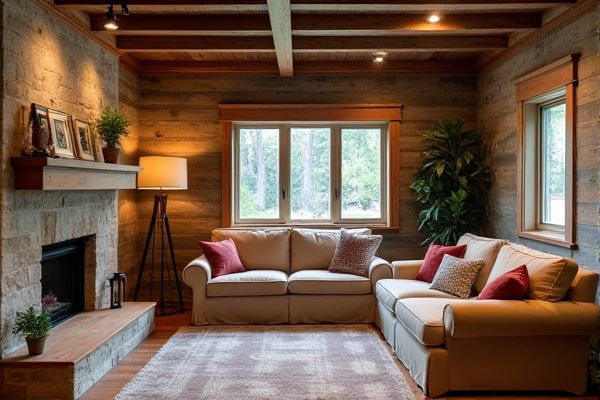
Barnboard accent offers a rustic, textured appeal perfect for adding warmth and character to your living spaces, while reclaimed wood in basements provides durability and a unique history that enhances the overall ambiance. Explore the differences and benefits of each to discover which material best suits your design vision and lifestyle.
Table of Comparison
| Feature | Barnboard Accent | Reclaimed Wood Basement |
|---|---|---|
| Material Source | Old barn wood, weathered timber | Recycled wood from demolished buildings or structures |
| Appearance | Rustic, textured, natural aged patina | Varied tones and textures, often mixed wood grains |
| Usage | Accent walls, decor highlights | Flooring, walls, ceilings in basements |
| Durability | Moderate, depends on wood condition | High, treated for moisture and wear resistance |
| Installation Complexity | Simple to moderate | Moderate to complex, requires moisture barriers |
| Cost | Affordable to moderate | Moderate to high, due to processing and treatment |
| Environmental Impact | Eco-friendly, repurposes old wood | Highly sustainable, reduces landfill waste |
Introduction to Barnboard and Reclaimed Wood
Barnboard refers to aged, weathered wood typically sourced from old barns, prized for its rustic texture and patina. Reclaimed wood encompasses a broader category that includes barnboard but also wood salvaged from various structures like factories, warehouses, and homes. Both barnboard and reclaimed wood offer eco-friendly materials with unique character and durability, making them popular choices for basement renovations and accent walls.
Key Differences Between Barnboard and Reclaimed Wood
Barnboard accent features wood salvaged specifically from old barns, characterized by its weathered texture, distinct grain patterns, and rustic charm, often showcasing nail holes and saw marks. Reclaimed wood from basements generally includes a variety of hardwoods with less distress but greater uniformity, offering a smoother finish and more consistent coloration. The key differences lie in barnboard's prominent aged appearance and historical character versus basement reclaimed wood's cleaner, more versatile look suitable for modern interior designs.
Aesthetic Appeal: Style and Visual Impact
Barnboard accents feature weathered textures and rich patinas that create a rustic, farmhouse-inspired aesthetic, adding warmth and character to interior spaces. Reclaimed wood basements utilize salvaged timber with varied grain patterns and natural imperfections, delivering an authentic, vintage charm that enhances visual depth. Both options provide sustainable, unique style elements, but barnboard accents typically offer more uniformity, while reclaimed wood introduces diverse tonal variations.
Authenticity and Sourcing of Materials
Barnboard accents offer unparalleled authenticity due to their origins from old barns, ensuring each piece carries unique textures and historical character. Reclaimed wood for basements often comes from diverse sources like demolished buildings or factories, providing varied but equally sustainable materials. Both emphasize eco-friendly sourcing, yet barnboard accents typically hold higher provenance and rustic appeal, making them prized for genuine vintage aesthetics.
Durability and Longevity in Basement Environments
Barnboard accent walls offer moderate durability in basement environments but may require additional treatment to resist moisture and pests, potentially limiting their longevity. Reclaimed wood, sourced from old structures and often already weathered, typically provides enhanced durability and longevity due to its denser grain and reduced susceptibility to warping or decay in damp basement conditions. Proper sealing and maintenance are crucial for both materials to maximize resistance against basement humidity, mold, and temperature fluctuations.
Installation Process and Requirements
Barnboard accents typically require precise cutting and fastening to create a decorative wall feature, often needing moisture barriers and proper ventilation to prevent warping in basements. Reclaimed wood for basement installation demands thorough cleaning, de-nailing, and sometimes kiln drying to ensure durability and prevent pest infestation. Both materials benefit from a sealed finish to protect against basement humidity and maintain long-lasting structural integrity.
Cost Comparison: Budgeting for Your Basement
Barnboard accent walls typically cost less than fully installing reclaimed wood throughout your basement due to lower material and labor expenses. Reclaimed wood flooring or paneling demands careful sourcing and preparation, increasing overall budget needs. Choosing barnboard accents offers a stylish, cost-effective way to add character without extensive investment.
Environmental and Sustainability Considerations
Barnboard accents use reclaimed wood that reduces deforestation by repurposing aged lumber, promoting sustainability in interior design. Reclaimed wood basements leverage salvaged timber that lowers landfill waste and minimizes carbon footprint compared to new construction materials. Both options contribute to eco-friendly practices by preserving natural resources and supporting recycling efforts in home renovation projects.
Maintenance and Care Tips
Barnboard accents require regular dusting and occasional sealing to preserve their rustic charm and prevent splintering, while reclaimed wood basements benefit from thorough cleaning and moisture control to avoid warping or mold growth. You should apply a protective finish to both materials to enhance durability, but reclaimed wood in basements demands more frequent inspections due to higher humidity levels. Proper maintenance ensures lasting beauty and structural integrity for your barnboard accents and reclaimed wood basement surfaces.
Choosing the Best Option for Your Basement Remodel
Barnboard accents offer a rustic, weathered charm with distinct textures ideal for creating focal points in basement remodels, while reclaimed wood provides versatile, eco-friendly options with varied finishes that enhance entire room aesthetics. When choosing between barnboard and reclaimed wood, consider the level of authenticity desired, durability requirements, and budget constraints for your basement renovation. Opting for barnboard accents works well for accent walls or decorative features, whereas reclaimed wood suits larger applications like flooring or paneling to achieve a cohesive, sustainable design.
 homyna.com
homyna.com